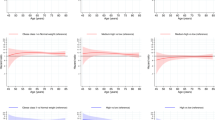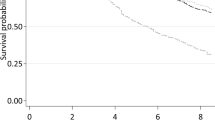Abstract
Background:
It is unclear if the body mass index (BMI) associated with minimum all-cause mortality is constant throughout adult life or increasing with age.
Methods:
We applied multivariable fractional polynomials to the data of the Vorarlberg Health Monitoring and Prevention Program to quantify the BMI associated with minimum mortality over age. The analysis included data of 129 904 never-smoking women and men (mean age: 45.4 years) who were followed for a median of 18.6 years.
Results:
Optimum BMI in women increased with age, lying within the normal BMI category (according to the World Health Organization definition) from the age of 20 years (23.3 kg m−2, 95% confidence interval (CI): 22.2–24.3) to the age of 54 years and in the lower half of the overweight category from the age of 55 years onwards, reaching 26.2 kg m−2 (95% CI: 25.1–27.3) at the age of 69 years. In men, optimum BMI increased slightly from 23.7 kg m−2 (95% CI: 22.1–25.2) at the age of 20 years until the age of 59 years, reaching a BMI of 25.4 kg m−2 (95% CI: 24.8–26.0) and decreased afterwards to 22.7 kg m−2 (95% CI: 20.9–24.6) at the age of 80 years.
Conclusions:
Our results indicate that BMI associated with minimum all-cause mortality changes with age and that patterns differ by sex. Sex- and age-independent BMI recommendations might therefore be inappropriate. Further studies using flexible methods instead of predefined categories are necessary to revise BMI recommendations.
This is a preview of subscription content, access via your institution
Access options
Subscribe to this journal
Receive 12 print issues and online access
$259.00 per year
only $21.58 per issue
Buy this article
- Purchase on Springer Link
- Instant access to full article PDF
Prices may be subject to local taxes which are calculated during checkout


Similar content being viewed by others
References
Berrington de, Gonzalez A, Hartge P, Cerhan JR, Flint AJ, Hannan L, MacInnis RJ et al. Body-mass index and mortality among 1.46 million white adults. N Engl J Med. 2010; 363: 2211–2219.
Whitlock G, Lewington S, Sherliker P, Clarke R, Emberson J, Halsey J et al. Prospective Studies Collaboration. Body-mass index and cause-specific mortality in 900000 adults: collaborative analyses of 57 prospective studies. Lancet 2009; 373: 1083–1096.
Troiano RP, Frongillo EA Jr, Sobal J, Levitsky DA . The relationship between body weight and mortality: a quantitative analysis of combined information from existing studies. Int J Obes Relat Metab Disord 1996; 20: 63–75.
Orpana HM, Berthelot J-M, Kaplan MS, Feeny DH, McFarland B, Ross NA . BMI and mortality: results from a national longitudinal study of Canadian adults. Obes (Silver Spring, MD) 2010; 18: 214–218.
Pischon T, Boeing H, Hoffmann K, Bergmann M, Schulze MB, Overvad K et al. General and abdominal adiposity and risk of death in Europe. N Engl J Med 2008; 359: 2105–2120.
Heiat A, Vaccarino V, Krumholz HM . An evidence-based assessment of federal guidelines for overweight and obesity as they apply to elderly persons. Arch Intern Med 2001; 161: 1194–1203.
Losonczy KG, Harris TB, Cornoni-Huntley J, Simonsick EM, Wallace RB, Cook NR et al. Does weight loss from middle age to old age explain the inverse weight mortality relation in old age? Am J Epidemiol 1995; 141: 312–321.
Kalmijn S, Curb JD, Rodriguez BL, Yano K, Abbott RD . The association of body weight and anthropometry with mortality in elderly men: the Honolulu Heart Program. Int J Obes Relat Metab Disord 1999; 23: 395–402.
Stevens J, Cai J, Pamuk ER, Williamson DF, Thun MJ, Wood JL . The effect of age on the association between body-mass index and mortality. N Engl J Med 1998; 338: 1–7.
Zamboni M, Mazzali G, Zoico E, Harris TB, Meigs JB, Di Francesco V et al. Health consequences of obesity in the elderly: a review of four unresolved questions. Int J Obes 2005; 29: 1011–1029.
Funada S, Shimazu T, Kakizaki M, Kuriyama S, Sato Y, Matsuda-Ohmori K et al. Body mass index and cardiovascular disease mortality in Japan: the Ohsaki Study. Prev Med 2008; 47: 66–70.
Klenk J, Nagel G, Ulmer H, Strasak A, Concin H, Diem G et al. Body mass index and mortality: results of a cohort of 184,697 adults in Austria. Eur J Epidemiol 2009; 24: 83–91.
Allison DB, Faith MS, Heo M, Kotler DP . Hypothesis concerning the U-shaped relation between body mass index and mortality. Am J Epidemiol 1997; 146: 339–349.
Allison DB, Faith MS, Heo M, Townsend-Butterworth D, Williamson DF . Meta-analysis of the effect of excluding early deaths on the estimated relationship between body mass index and mortality. Obes Res 1999; 7: 342–354.
Royston P, Altman DG . Regression using fractional polynomials of continuous covariates: parsimonious parametric modelling. J R Stat Soc Ser C 1994; 43: 429–467.
Sauerbrei W, Royston P . Building multivariable prognostic and diagnostic models: transformation of the predictors by using fractional polynomials. J R Stat Soc Ser A 1999; 162: 71–94.
Boffetta P, Islami F, Vedanthan R, Pourshams A, Kamangar F, Khademi H et al. A U-shaped relationship between haematocrit and mortality in a large prospective cohort study. Int J Epidemiol 2013; 42: 601–615.
Bakker R, Steegers EAP, Raat H, Hofman A, Jaddoe VWV . Maternal caffeine intake, blood pressure, and the risk of hypertensive complications during pregnancy. The Generation R Study. Am J Hypertens 2011; 24: 421–428.
Oreopoulos A, McAlister FA, Kalantar-Zadeh K, Padwal R, Ezekowitz JA, Sharma AM et al. The relationship between body mass index, treatment, and mortality in patients with established coronary artery disease: a report from APPROACH. Eur Heart J 2009; 30: 2584–2592.
Claessen H, Arndt V, Drath C, Brenner H . Overweight, obesity and risk of work disability: a cohort study of construction workers in Germany. Occup Environ Med 2009; 66: 402–409.
Wong ES, Wang BCM, Garrison LP, Alfonso-Cristancho R, Flum DR, Arterburn DE et al. Examining the BMI–mortality relationship using fractional polynomials. BMC Med Res Methodol 2011; 11: 175.
Willett WC, Dietz WH, Colditz GA . Guidelines for healthy weight. N Engl J Med 1999; 341: 427–434.
Rapp K, Schroeder J, Klenk J, Stoehr S, Ulmer H, Concin H et al. Obesity and incidence of cancer: a large cohort study of over 145,000 adults in Austria. Br J Cancer 2005; 93: 1062–1067.
Ulmer H, Kelleher C, Diem G, Concin H . Long-term tracking of cardiovascular risk factors among men and women in a large population-based health system: the Vorarlberg Health Monitoring & Promotion Programme. Eur Heart J 2003; 24: 1004–1013.
Ambler G, Royston P . Fractional polynomial model selection procedures: investigation of type i error rate. J Stat Comput Simul 2001; 69: 89–108.
WHO. Global Database on Body Mass Index [Internet]. Available at: http://apps.who.int/bmi/index.jsp [last accessed 29 July 2013).
Rössner S . Obesity in the elderly—a future matter of concern? Obes Rev 2001; 2: 183–188.
Durazo-Arvizu R, McGee D, Li Z, Cooper R . Establishing the nadir of the body mass index–mortality relationship: a case study. J Am Stat Assoc 1997; 92: 1312–1319.
BMI in Diverse Populations Collaborative Group. Effect of smoking on the body mass index-mortality relation: empirical evidence from 15 studies. Am J Epidemiol 1999; 150: 1297–1308.
Yoong SL, Carey ML, D’Este C, Sanson-Fisher RW . Agreement between self-reported and measured weight and height collected in general practice patients: a prospective study. BMC Med Res Methodol 2013; 13: 38.
Acknowledgements
We thank all physicians and participants in the VHM&PP for completing the study examinations and providing data. In addition, we want to thank Elmar Stimpfl, Jochen Klenk, Ella Fromm, Chad Logan and Ursula Berger. The VHM&PP is supported by the State of Vorarlberg, Austria. We thank Markus Wallner, Christian Bernhard, Andrea Kaufmann and Gabriela Dür from the Vorarlberg State Government.
Author information
Authors and Affiliations
Corresponding author
Ethics declarations
Competing interests
The authors declare no conflict of interest.
Additional information
Supplementary Information accompanies this paper on International Journal of Obesity website
Supplementary information
Rights and permissions
About this article
Cite this article
Peter, R., Mayer, B., Concin, H. et al. The effect of age on the shape of the BMI–mortality relation and BMI associated with minimum all-cause mortality in a large Austrian cohort. Int J Obes 39, 530–534 (2015). https://doi.org/10.1038/ijo.2014.168
Received:
Revised:
Accepted:
Published:
Issue Date:
DOI: https://doi.org/10.1038/ijo.2014.168
This article is cited by
-
Association of long-term exposure to various ambient air pollutants, lifestyle, and genetic predisposition with incident cognitive impairment and dementia
BMC Public Health (2024)
-
Frequency and Types of Pathological Upper Gastrointestinal Endoscopy Findings in Clinically Healthy Individuals
Drugs in R&D (2020)
-
Predictors of long-term survival prior to permanent pacemaker implantation in octogenarians or older
Aging Clinical and Experimental Research (2019)
-
Sex-specific associations between adolescent categories of BMI with cardiovascular and non-cardiovascular mortality in midlife
Cardiovascular Diabetology (2018)
-
Association between body mass index and diabetes mellitus in tuberculosis patients in China: a community based cross-sectional study
BMC Public Health (2017)



